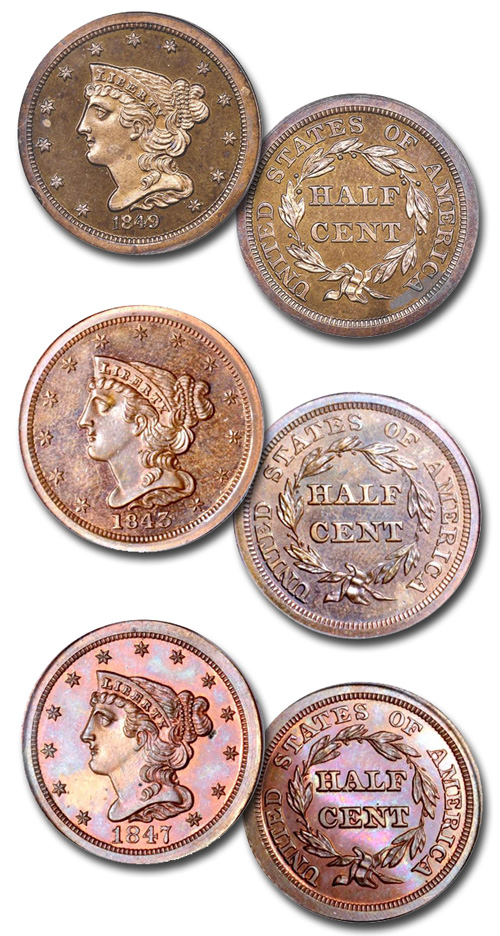
Answer: If you would like to learn as much as there is to know, at least per the state of the art in 1983, Walter Breen’s Encyclopedia of United States Half Cents, 1793-1857, is the best single source. However, the book may be “information overload,” as it is laden with technicalities. If your interest is more casual, Walter Breen’s Complete Encyclopedia of U.S. and Colonial Coins, 1988, is very useful.
As to an overview, of the dates you mention, only the 1831 was struck for circulation, and only to the extent of about 2,200 pieces. Now and again a worn example appears for sale, but such are few and far between. The dates 1836, 1840 to 1848 (which span includes the 1843 you mention), 1849 Small Date, and 1852 were made only in Proof format.
After 1811, half cents were redundant in United States commerce. Contrary to expectations in 1793, when the first coins of this denomination were made, this small denomination was not particularly popular. After 1811, no further examples were struck until 1825. Although fair numbers were struck in 1825, 1826, 1828, 1829, and 1832 to 1835, they did not circulate widely. I have found scarcely any contemporary newspaper accounts of such coins during this period, although many goods and services were priced in figures ending in a half cent, such as 12-1/2 cents and 37-1/2 cents. Such were paid for in Spanish American coins, the 12-1/2 cent piece or “bit” being a popular denomination. Two bits equaled a quarter dollar, the origin of the “two bits” term sometimes heard today.
For the Proof-only issues 1840 to 1849 Small Date, a handy rule of thumb is that “originals” made for collectors and for inclusion in presentation sets of that era all shared a reverse die with large berries in the wreath. Later, there were likely two restriking sessions each using the original obverse dies for the preceding, but with one run utilizing a later “small berries” reverse with slight doubling on the wreath ribbon and NT (of CENT); this die had been used earlier to make regular, i.e. original half cents of 1856. On another restriking run, a different “small berries” reverse was used, this one with parallel diagonal die scratches from the border down toward RICA (AMERICA).
Likely the originals were produced year by year, such as in 1840, then 1841, then 1842, and so on. The so-called first restrikes, using a reverse die also employed to make Proof half cents of 1856, were probably made at one time or at least in one limited time period after 1856, possibly beginning in 1859. The second restrikes with a different small-berries reverse are believed to have been struck later. Such shenanigans seem to have gone on through at least the early 1870s, and perhaps still later.
In addition to the three “runs” mentioned above (the one-year-at-a-time originals and two runs of restrikes), some few others were made now and then, as detailed in the 1983 Breen book. Beyond Breen, updates and other information have been published in Penny-Wise, journal of the Early American Coppers club, Dr. Harry Salyards, editor.
There are many electrotypes and fakes around of these rare half cents. I suggest that you limit any purchases to those certified by one of the leading services. In my opinion, these rare Proofs are very inexpensive in comparison to their elusive nature. This is probably because there are over a dozen Proof-only issues (including, for all practical purposes, the 1831 in the list), and it is daunting to contemplate them at all.





